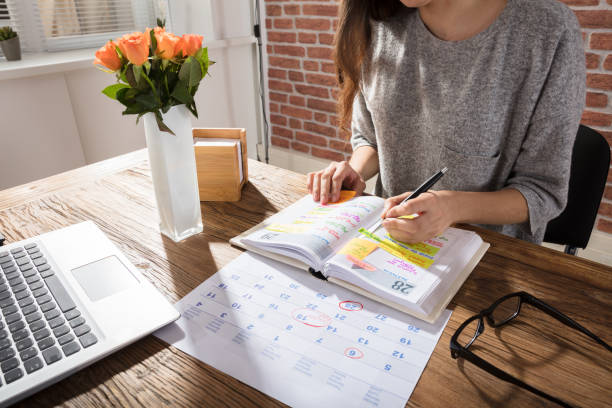
Living with ADHD can often feel like navigating a chaotic sea of thoughts, tasks, and responsibilities. The constant swirl of distractions and impulsivity can make staying organized and on top of daily life challenging. No matter how much you may care about someone, you might still forget their birthday. No matter how important you know that deadline is, you might still struggle to begin in a timely manner instead of waiting on the rush of time pressure to help you get it done. The challenges that accompany planning and time management in ADHD are not to be taken lightly. However, a powerful tool can act as a guiding compass in this storm – a planner.
Having a planner to refer to can help you lay out your tasks, appointments, and important events in a clear manner. It helps to alleviate concerns that you are forgetting something or that a deadline is coming up (or has passed). Not only is it helpful to refer to your planner to see what is on the horizon, but it takes away some of the mental load of worrying that you’re going to forget. It may take getting used to use it, but once you do, you will have a life hack sitting out for you to see.
The Effects of ADHD on Planning
ADHD is more than just a difficulty in focusing; it can significantly affect executive functions such as organization, time management, and planning. Individuals with ADHD often struggle with maintaining a structured routine, remembering important dates, and prioritizing tasks. This can lead to feeling overwhelmed and frustrated as they try to navigate a world that seems to demand meticulous planning and attention to detail. Feelings of shame can arise as the people around you inherently become tasked with helping you stay on top of things. A core goal of ADHD therapy is addressing this stress with a set of actions that can be taken.
5 Ways You Can Use a Planner to Help You with ADHD
1) Visual Organization:

Planners provide a visual and tangible way to lay out daily, weekly, and monthly plans. Use color-coded sections, ink, stickers, or icons to differentiate tasks and make the planner visually stimulating. Ideally, you can find a planner with a month-at-a-glance, followed by weeks broken down, with lots of space to write out what is needed.
Being able to mark down due dates, appointments, social plans, errands, and even chores can give you something tangible that reassures you you aren’t letting anything slip. It can also help you to stay motivated; checking off something from a list is a satisfying little way to reward your brain. So much stress comes from worrying you’re forgetting something or have forgotten it; knowing it is written down and you are able to confirm that you noted it frees up your mind for other things.
Create the kind of journal layout that you will appreciate looking at and be able to maintain. A bullet journal is great in theory, but if you never finish creating it, you fall behind and might abandon it entirely. There are so many different types and formats of journals that can be found locally and/or online. Pick the one that meets every single one of your organizational needs; you want to keep your planner up-to-date to require as little work as possible and for the results to show you a clear picture of your day, week, and month at a glance.
Listing errands, tasks, and to-dos is effective, as is breaking your planner down into actual blocks of time. Looking at a section of a page and knowing that that has been allocated and set aside keeps you focused on taking projects one step at a time. A big empty sheet of white paper looks far more foreboding and lacks the structure to reassure you that you will manage and won’t forget anything.
2) Break Down Tasks:

When we consider being overwhelmed, we have to look at the size of the tasks we are taking on and evaluate if we can make those tasks less imposing. Break down complex projects into smaller, more manageable tasks and allocate them across different days or weeks. A planner allows you to create a step-by-step roadmap, making it easier to approach tasks without feeling overwhelmed.
Begin by writing in what cannot be adjusted: work schedules, appointments, etc. Once those obligations are noted, you can consider where you see spaces that might work in your favor. For example, if you have a report due in two weeks, you can assign working on it to the spots available in your calendar. Not only that, but break the project down: one day for research, one day for outlining, one day for a certain length goal, another day for another length goal, and another for proofreading and bibliography. If you finish things earlier than you had intended, you can go to that spot in your planner and mark them as completed. If you don’t, your deadline remains. These deadlines are a great way to create urgency that benefits those with ADHD without actually procrastinating on the entire project.
Breaking down tasks also means being specific. There is a difference between marking down “Errands” and marking down which stores you are going to. ‘Groceries @ Gelson’s’ and ‘Aldo @ Westfield’ are specific. You may choose to keep your shopping list in your planner or not. But blocking out time to commute, park, walk around, shop, etc., is more realistic when you know what things you actually intend to get done, as opposed to a vague plan of ‘Errands.’ You may also recognize that certain errands work better at certain times or days when you’ll already be in the area or can come straight home afterward. Breaking tasks down into steps can enable you to see where you can get three small steps of three different goals done more easily and efficiently.

3) Set Realistic Goals and Prioritize:
Having a planner doesn’t eliminate your ADHD, nor does it add more time in the day or days in the week. Properly utilizing a tool like a planner can make a big difference in your life, but the planner alone isn’t going to work miracles. By visually laying out commitments, it becomes easier to see the bigger picture and make informed decisions about where to invest time and energy. This can be helped by using different ink colors or symbols for different categories: if your planner is all red one week, you are either scheduling too many important things in a cluster, or you’ve been dealt a rough hand by the gods of time management. You want to see where your imperative obligations are, where you’re doing self-care, where you’ve got flexibility, and so on.
You may have goals you have come up with in your therapy for ADHD, such as setting aside time for journaling. Writing down the time to do so and blocking it off will help you remember that this act of self-care is a priority. If that is helpful, you may even begin to make personal notes in your planner and write longer content elsewhere.
Being realistic doesn’t mean you don’t make big plans; it means you break them down into tasks you can take on. It might also mean that you need more time than you’d like to achieve them. How can you create a schedule and prioritize it so that you are working on what you can handle to move toward your intended outcome?
If you experience decision paralysis, you may be unsure how to sort out your top priorities. This can also lead to decision fatigue. Eliminate the question marks first. Shifts set by your employer, classes dictated by the institution, and activities scheduled by the organization hosting them are all non-negotiables. You may want to consider if all of these are your top priorities. If not, consider how you might adjust your schedule to eliminate something.
4) Establish Consistent Routines:

Consistent routines can provide a sense of stability and predictability, helping to manage the unpredictable nature of ADHD. Routines are a cornerstone of ADHD treatment; the trick is figuring out the routine that works best for you. When you use a planner, you can map out your time and reserve specific times or days of the week for what matters to you.
There is no plan too “small” or “silly” to write down. If you have to make a list of every little thing, do it! Go through the entire planner and mark down reminders about trash pickup days. Take each week as it comes and figure out where you can do laundry; is it possible that the same day(s) of the week work consistently for you? Can that become a routine?
Not only can you mark down things you can’t forget because they’ll happen whether you remember them or not, but you can also begin to build time for the things you keep meaning to get to. What is it that you want to create time for? Do you want to go to the gym, learn a language, spend more time with friends? Are you hoping to change a space in your house, but first, you need to clean out an area? How can you mark time to tackle one drawer a day or one shelf a week so that you can make that happen? In the same way, it is satisfying to cross items off a to-do list; it is motivating to see things listed. In this way, your planner becomes your inspiration.
Another way a planner assists you in creating structure and routine is that it is a written record of what you have already done. When you have your weeks laid out, their history is a resource you can refer to when considering how to prioritize plans, what balance of obligations works well for you, and so on. Sometimes, studying your week at a glance will tell you all you need to know about how that week went. Other times, you might be surprised at how overwhelmed you were by your schedule. At the end of a week like that, if you feel burnt out and frazzled, you can make a note somewhere on the pages of that week. You might give yourself suggestions, such as, “Don’t schedule x and y in the same week again!” or, “This was a lot – bump x deadline if these events occur like this again!”
5) Utilize Reminders and Alarms:

You might have gotten this far wondering how you’ll remember to use your planner in the first place. Set an alarm. Did you pack your planner? Have you checked your planner today? (Hopefully, you can keep it somewhere that is hard to ignore.) The auditory and visual cues act as external prompts, compensating for potential lapses in attention or forgetfulness. You can also utilize electronic reminders to add things to your planner if you don’t have it with you. Set it for when you know you’ll be near your planner, and then you can forget about it.
If you tend to hyper-focus on specific tasks, an alarm is a good way to make sure you will pause at some point. When you have laid out the timeline of events that you feel will work best for you, getting sidetracked and running behind can be very discouraging. It is best to set yourself up for success using any and every tool at your disposal.
You can utilize alarms to help you use your planner, and you can go through your planner to make sure you have set appropriate alarms. For example, set an alarm if you know you’ll need to leave one place by a certain time to get everything on your schedule done. Make sure the alarm goes off at a time that allows you to close whatever task you’re doing and gather your things.
The idea of utilizing a planner can raise questions and concerns: what if I forget to write things down; what if I forget my whole journal somewhere; what if I lose motivation? These are all possibilities for which you can make a contingency plan. The key is to begin. Start somewhere and build your planner habits through practice. Yes, sometimes you’ll forget your planner or mean to check it and get distracted. Sometimes, you’ll have to make a note on your phone, or a sticky note, or somewhere else and have to transcribe it later. Just because something might not be perfect doesn’t mean you don’t try it out. Once you get in the habit of utilizing this visual aid, you will learn how best to make it work for you. The goal is to free your mind of additional stress and worry and enable you to create schedules and structures that support your best life!
ADHD Treatment in Woodland Hills, CA
ADHD in adults looks quite different than in kids. If you are someone who was diagnosed as a child, you may find out that you need a new set of skills to manage your ADHD. If you are someone who is diagnosed with ADHD as an adult, you may feel like you have no idea how to manage your ADHD. ADHD Treatment in our offices in Woodland Hills is designed to identify the unique challenges of your ADHD brain and create action steps that can be efficiently and effectively integrated into your life. Contact us today for your complimentary 20-minute phone consultation with our Admin Team today!




